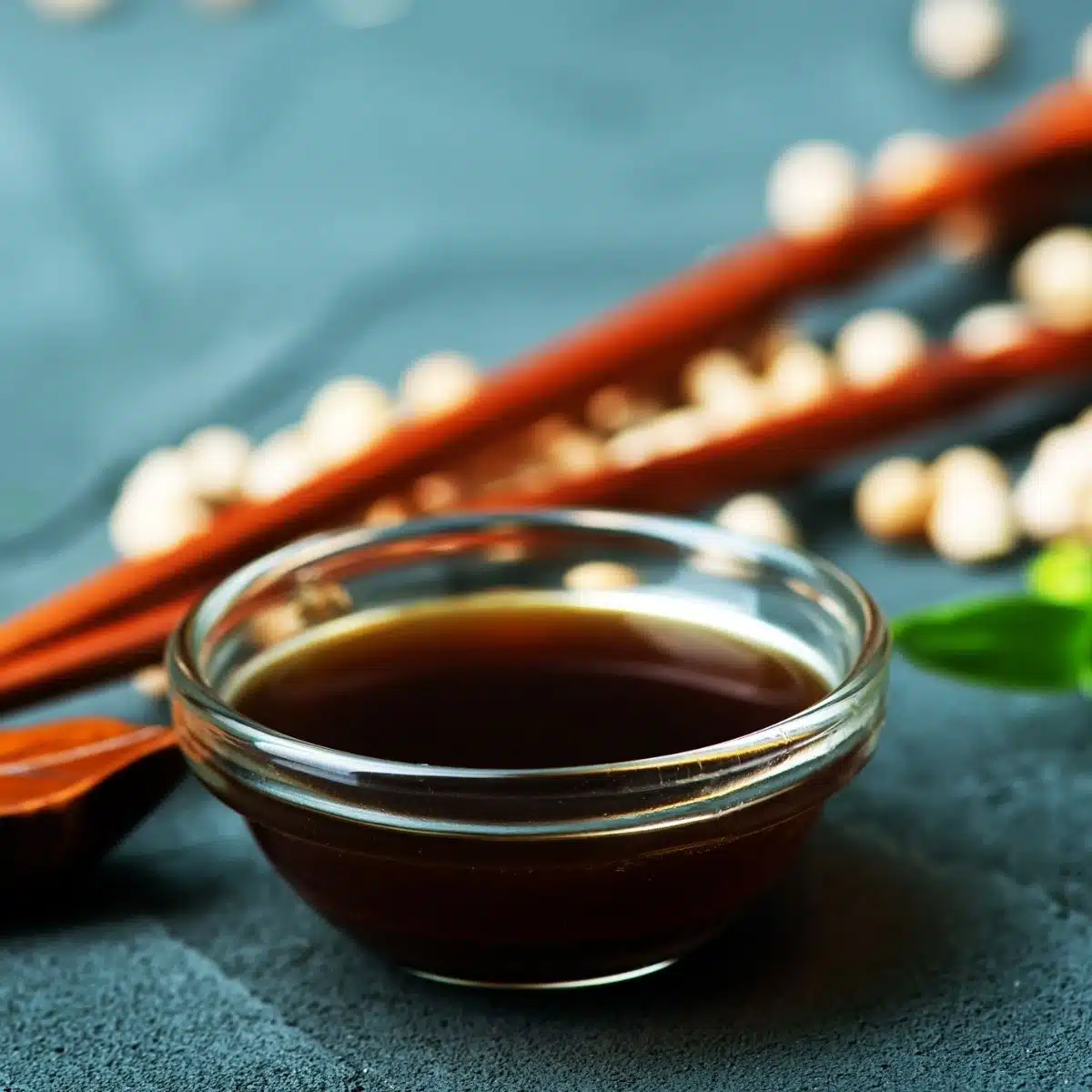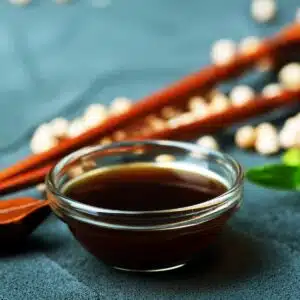Know how to choose the best soy sauce substitute when a recipe calls for the salty, umami flavor of soy sauce but you don't have any! Soy sauce is usually a key ingredient- so don't skip it, just find the right replacement!

All the best ingredients to swap out for soy sauce when cooking!
A staple for centuries in Asian cuisine, soy sauce made its way into the hearts of people worldwide in the last century. It has even moved beyond just being a staple in Asian cuisine and made a name for itself as a great addition to marinades, especially to help tenderize meat.
With so many uses in a home cook’s kitchen, running out of this simple condiment mid-recipe may leave you looking for a substitute. Luckily, there are plenty of tasty substitutes you can turn to.
Jump to:
- Best Substitutes That Taste Like Soy Sauce
- 1. Tamari
- 2. Shoyu Sauce
- 3. Liquid Aminos
- 4. Coconut Aminos
- The Best Substitutes With Complex Flavors
- 5. Worcestershire Sauce
- 6. Fish Sauce
- 7. Chopped anchovies
- 8. Oyster Sauce
- 9. Hoisin Sauce
- 10. Teriyaki Sauce
- 11. Maggi Seasoning
- 12. Miso Paste
- The Best Soy Sauce Substitutes in a Pinch
- 13. Salt
- 14. Mushrooms
- 15. Homemade Soy Sauce
- 📖 Recipe Card
- 💬 Comments & Reviews
Some of these substitutes will give you a very close match to soy sauce, while others elevate the flavor beyond the simple flavors of soy sauce.
There are even several gluten-free options, for those needing a long-term substitute for soy sauce.
Best Substitutes That Taste Like Soy Sauce
1. Tamari
Tamari is a Japanese-style sauce that is also made from fermented soybeans, which gives it a very close flavor to Chinese soy sauce. There are two main differences between tamari and soy sauce.
One, tamari is a bit thicker than soy sauce. Two, unlike soy sauce that contains wheat, tamari (*usually) does not contain any wheat.
This makes tamari a great choice for those who need a gluten-free soy sauce. *as more brands started producing tamari, some have started to add wheat to their sauce; therefore, if you have a gluten sensitivity, always check the bottle before using.
Use tamari in a 1:1 exchange for soy sauce in any recipe.
2. Shoyu Sauce
Shoyu Sauce is Japanese soy sauce. Unlike tamari though, it contains almost 50% wheat. This makes it a bit sweeter than Chinese soy sauce.
Even though it is slightly sweeter and less salty than Chinese soy sauce, it is still a great substitute! It is especially good for replacing soy sauce in marinades or other sauce-based recipes.
Shoyu can be used in a 1:1 exchange for soy sauce in any recipe; however, you may want to add a dash of salt to balance out the sweetness and get a closer salty flavor profile to soy sauce.
3. Liquid Aminos
Liquid aminos are a complete protein source of amino acids. The protein in liquid aminos comes from soybeans, which provides them with a similar taste to soy sauce.
The soybeans in liquid aminos are not fermented though. Like tamari, liquid aminos are also gluten-free.
In fact, brands like Bragg’s are always gluten-free so if you are concerned about possible wheat in tamari then liquid aminos are a great choice.
Since the overall flavor profile of liquid aminos is milder than soy sauce, it can easily be used in a 1:1 substitution for soy sauce in any recipe.
4. Coconut Aminos
Coconut aminos are another liquid amino, except they come from the sap of coconut trees instead of soybeans. This makes them a great soy sauce substitute for anyone with allergies since they are both gluten-free and soy-free.
While coconut aminos are free from two things that make-up soy sauce, it is surprisingly similar in taste. It does have a slightly sweeter flavor profile though and less sodium.
Easily substitute coconut aminos in a 1:1 exchange for soy sauce in any recipe that you want to make soy and gluten free.
The Best Substitutes With Complex Flavors
5. Worcestershire Sauce
You may be surprised to find that this sauce from across the pond is a good flavor substitute for soy sauce in most dishes. Worcestershire goes through a similar fermentation process which gives it a strong salty flavor profile like soy sauce.
\Worcestershire sauce is more complex than soy sauce though, as it is made from several ingredients – including anchovies. Therefore, if you are vegan or vegetarian then you will want to avoid this option.
Overall, Worcestershire sauce is stronger than soy sauce. So it is best to begin with less and add more as needed. Start with half the amount the recipe calls for in soy sauce and then give it a taste. Add more, up to an even 1:1 exchange, as needed.
6. Fish Sauce
Fish sauce is just like what it sounds like – sauce made from fish. It is a popular condiment in Asian cuisine and is made from fermenting small fish like krill or anchovies.
It offers the saltiness that soy sauce adds to many dishes, but also has a distinct flavor that some find to be quite fishy. If you commonly use fish sauce in your cooking or are wanting to add more complex flavors to your recipe, this is a good substitute for soy sauce.
Like Worcestershire sauce, fish sauce is stronger than soy sauce; therefore, start with half the amount and add more as needed.
7. Chopped anchovies
This substitute won’t be for everyone, but if you enjoy the saltiness that anchovies offer to a dish then you can add a finely chopped anchovy to a dish in place of soy sauce.
This won’t work in dishes where you need the liquid of the soy sauce, but if you are simply looking to elevate the salty and savory flavors this is an easy substitute.
Finely chop up 1 anchovy for every tablespoon of soy sauce you need to replace.
8. Oyster Sauce
Oyster sauce is another popular Asian condiment. It is made similarly to fish sauce, except with oysters.
Unlike fish sauce though, it does not have a strong seafood taste. It is also less salty than fish sauce and soy sauce.
Oyster sauce is best used as a substitute for soy sauce in dishes where you want a more complex flavor profile with a bit of sweetness. It also is a great choice for sauces that you want to be a bit thicker.
Oyster sauce can be used in a 1:1 substitution for soy sauce. However, since it is quite a bit sweeter you may want to start with less or add additional salt to get the saltiness missing from the soy sauce.
9. Hoisin Sauce
If you make a lot of Asian barbeque, then you may have hoisin sauce on hand. This sauce is quite a bit thicker than soy sauce since it is often used to glaze meats or as a dipping sauce.
While it has a more complex consistency and flavor profile than soy sauce, it is a yummy option for those who want to take their stir-fry to the next level. Use hoisin sauce in a 1:1 exchange for soy sauce.
Due to its thickness, you may want to thin out the hoisin sauce with a bit of water first and then measure the thinner sauce in a 1:1 ratio.
10. Teriyaki Sauce
Depending on what you are making, teriyaki sauce can be a tasty substitute for soy sauce. It won’t provide an exact flavor exchange, but if you don’t mind adding a bit of sweetness to your dish, then teriyaki sauce is great.
Teriyaki sauce works best in stir-fry dishes, as a topping for rice bowls, or as a base for a marinade. It can be used in a simple 1:1 exchange for soy sauce.
11. Maggi Seasoning
This is a substitute that only a few may already have in their pantry. If you happen to have a jar of this rich umami flavored seasoning – give it a try in place of soy sauce!
Maggi seasoning is a Swedish condiment that is made from fermented wheat proteins. Therefore, it has many of those similar flavors to soy sauce.
One big difference is that it is a dry seasoning, rather than a liquid. Maggi seasoning is best used as an addition to dishes where you can add a little bit at a time. Dishes like stir-fry or soup would be ideal.
Add a dash at a time, stir, taste, and add more if needed.
12. Miso Paste
Miso paste is made from fermented soybeans, so it offers a similar flavor profile to soy sauce. The main difference is the consistency of the paste is quite different than the liquid of soy sauce.
If you want to use miso paste as a substitute, it works best in soups or sauces where you can dissolve the miso paste into other liquids.
You can also mix the miso paste with a little bit of water first. Once fully combined, you can then measure the liquid in a 1:1 exchange for soy sauce.
The Best Soy Sauce Substitutes in a Pinch
13. Salt
In a lot of dishes, soy sauce is used to add saltiness. While salt on its own won’t offer the savory umami flavors of soy sauce, in a pinch – you can use a pinch of salt to enhance the flavor of the dish.
Like the anchovies, this will simply add salt to the overall recipe but won’t work when you need a liquid substitute.
14. Mushrooms
One of the main flavors that soy sauce provides is an umami flavor. Umami is the earthy and savory taste that is associated with many Asian dishes.
Since mushrooms have a similar umami flavor, they can be a good soy sauce substitution in some recipes. There are a few different ways you can use mushrooms as a substitute.
If using fresh mushrooms, use them in a stir-fry or a soup where the soy sauce is intended to elevate the other flavors. To get the most flavor from the mushrooms, sauté them in a bit of oil to bring out the flavor before adding them to the rest of the dish.
There is not a direct ratio exchange, so feel free to use what looks best for the dish you are making. One main thing missing from mushrooms is the saltiness of the soy sauce, so you may want to add some additional salt to your recipe.
Mushroom Broth
If you need a liquid base, you can use fresh mushrooms to form a simple mushroom broth. Simply boil 1 cup of chopped mushrooms in about 1 cup of water.
If you want, you can begin by first sauteing them in a pan and then slowly add some water to the pan and simmer. Measure the broth in a 1:1 exchange for soy sauce in liquid-based recipes.
Dried Shiitake Mushrooms
If you happen to have dried shiitake mushrooms on hand, then you can soak them in water to create another form of mushroom broth. This will work best for a soup or sauce that you just want to enhance the savory flavors.
After allowing the mushrooms to soak in the water, remove the mushrooms. Then measure the liquid in a 1:1 ratio for soy sauce.
Depending on how strong the flavor is, you may want to add more. Taste and adjust the amount as needed.
15. Homemade Soy Sauce
Sometimes, the best substitutes are to simply make your own at home! Soy sauce is quite simple to make at home and if you want the closest replacement then this is the way to go.
- 1 ½ cup boiling Water
- 4 tablespoons Beef Bouillon Granules
- 4 tablespoons Apple Cider Vinegar
- 1 tablespoon Dark Molasses
- 1 teaspoon Sesame Seed Oil (or vegetable or canola oil)
- A pinch of Black Pepper
Bring water to a boil and whisk in all the ingredients. When the bouillon granules have dissolved completely, remove, and pour into an airtight container. Refrigerate for up to 1 month.
We wish you the best of luck with your dish and hope we've helped you find the perfect soy sauce substitute! Please let us know how everything turns out by leaving us a comment below!
Do you love a recipe you tried? Please leave a 5-star 🌟rating in the recipe card below and/or a review in the comments section further down the page.
Stay in touch with me through social media @ Pinterest, Facebook, Instagram, or Twitter! Subscribe to the newsletter today (no spam, I promise)! Don't forget to tag me when you try one of my recipes!
📖 Recipe Card
Best Soy Sauce Substitute: Homemade Soy Sauce (+More Great Ideas!)
Ingredients
- 1 ½ cups boiling water
- ¼ cup beef bouillon granules
- ¼ cup apple cider vinegar
- 1 tablespoon dark molasses
- 1 teaspoon sesame seed oil (or vegetable oil, or canola oil)
- 1 pinch ground black pepper
(Note: 2x or 3x only changes the ingredient list)
Instructions
- Bring water to a boil and whisk in all the ingredients. When the bouillon granules have dissolved completely, remove and use.
- Store in an airtight container and keep refrigerated for up to 1 month.
Notes
- Yields 2 cups homemade soy sauce.



Comments
No Comments